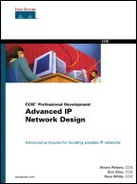Answers to Chapter 5 Review Questions
| 1: | What parameters must be matched for OSPF routers to become adjacent? |
| A1: | Hello interval, Dead interval, Wait interval, and the link type. |
| 2: | Is it ever normal for two OSPF routers to reach only a two-way state? When? |
| A2: | Yes; when neither one of them are DR or BDR on a multi-access network. |
| 3: | What is a good way to test for MTU mismatches? |
| A3: | Extended ping using various packet sizes. |
| 4: | Explain why having a router dial backup beyond the point of summarization is bad. |
| A4: | The only way to make it work is to inject more specific routes into the routing table of all the other routers in the network, which can cause problems. (It won't scale.) |
| 5: | What options do you have with a remote dual-homed into two different areas? |
| A5: | Place the remote link in one of the two areas, which results in suboptimum routing and loss of connectivity if the router loses its connection to that area. Place the remote link in a third area and build virtual links to area 0; create statics and redistribute them into the two areas. |
| 6: | Explain how you can end up throwing packets away if you summarize on Routers A and B in Figure 5-17 to 172.27.0.0/16?Figure 5-17. Diagram for Review Question 6
|
| A6: | If Router A or Router B lose their connection to one of the Ethernet links, but they are still advertising the 172.27.0.0/16 summary, they will throw away packets that are destined to the network to which they are no longer connected. |
| 7: | Can you have multiple areas with the same area number? |
| A7: | Yes. When routes are advertised into area 0 (the core area), all information about the area that they originated from is removed. |
| 8: | What one issue must you design around when dealing with dial-in links? |
| A8: | Host routes injected by the terminal service whenever a client connects. |
| 9: | Where are external LSAs flooded? |
| A9: | Through all areas except for stubby areas. |
| 10: | What type of SPF run is required when the state of external links change? |
| A10: | Partial. (Note that this doesn't mean all routers implement partial SPFs; it means only that a partial is all that is required.) |
| 11: | How do you inject default routes into OSPF? |
| A11: | With the default-information originate command. |
| 12: | What does the always keyword do on the end of the default-information originate command? |
| A12: | always originates a default route, regardless of the existence of a default in the routing table. |
| 13: | What is the Forward Address in the OSPF database used for? |
| A13: | To allow an OSPF router to forward packets directly to the next hop toward an external destination rather than through the ASBR. |
| 14: | What is the difference between a totally stubby area and a stubby area? |
| A14: | Totally stubby areas do not receive information on internal or external OSPF routes outside of the area; stubby areas receive internal, but not external, routing information. Neither can contain an ASBR. |
| 15: | Implement OSPF on the network you redesigned for review question 11 in Chapter 4, "Applying the Principles of Network Design." Place the ASBRs, deal with any design issues raised, and decide which areas can be stubbed. |
..................Content has been hidden....................
You can't read the all page of ebook, please click here login for view all page.

